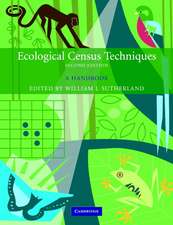Birds as Useful Indicators of High Nature Value Farmlands: Using Species Distribution Models as a Tool for Monitoring the Health of Agro-ecosystems
Editat de Federico Morelli, Piotr Tryjanowskien Limba Engleză Hardback – 13 feb 2017
This book focuses on suitable methods for monitoring the HNV areas, and presents the results of several case studies. The chapters put forward ways to integrate ecosystems assessment, geographical information systems (GIS) and strategies for conservation of local biodiversity. An innovative framework focuses on the use of species distribution models (SDMs) in order to explore the importance of each characteristic of HNV farmlands.
Furthermore, the book examines the relationships among bird species richness, land use diversity and landscape metrics at a local scale in the farmlands.
| Toate formatele și edițiile | Preț | Express |
|---|---|---|
| Paperback (1) | 575.93 lei 6-8 săpt. | |
| Springer International Publishing – 13 iul 2018 | 575.93 lei 6-8 săpt. | |
| Hardback (1) | 779.26 lei 6-8 săpt. | |
| Springer International Publishing – 13 feb 2017 | 779.26 lei 6-8 săpt. |
Preț: 779.26 lei
Preț vechi: 950.31 lei
-18% Nou
Puncte Express: 1169
Preț estimativ în valută:
149.15€ • 155.12$ • 124.99£
149.15€ • 155.12$ • 124.99£
Carte tipărită la comandă
Livrare economică 13-27 martie
Preluare comenzi: 021 569.72.76
Specificații
ISBN-13: 9783319502823
ISBN-10: 3319502824
Pagini: 120
Ilustrații: IX, 120 p. 43 illus., 35 illus. in color.
Dimensiuni: 155 x 235 x 10 mm
Greutate: 0.36 kg
Ediția:1st ed. 2017
Editura: Springer International Publishing
Colecția Springer
Locul publicării:Cham, Switzerland
ISBN-10: 3319502824
Pagini: 120
Ilustrații: IX, 120 p. 43 illus., 35 illus. in color.
Dimensiuni: 155 x 235 x 10 mm
Greutate: 0.36 kg
Ediția:1st ed. 2017
Editura: Springer International Publishing
Colecția Springer
Locul publicării:Cham, Switzerland
Cuprins
Summary.- Introduction.- 1.1. Decline of the biodiversity in agro ecosystems in the last decades (Morelli, Tryjanowski).- 1.2. Differences between Western and Eastern Europe agriculture – the role of history (Tryjanowski).- 1.3. Conservation tools.- 1.4. A systematic literature review of HNV farmland and requirements for future researches: there is a long way ahead (Benedetti).- 1.5. The HNV as support for biodiversity (Morelli).- 2. Methodology and tools for study and monitoring HNV.-2.1. Identifying HNV areas using Geographic Information Systems – GIS.- 2.2. Suitable frameworks to monitoring the HNV farmland using bird species.-2.3. Different ways to study the biodiversity: from species richness to the role of species in the community and functional diversity approach (Morelli) .-2.4. The concept of bioindicators (focal species, umbrella species, etc.) (Morelli) .-2.5. Species Distribution Models develop and assessment (Morelli).- 3. Case studies.- 3.1. Case study in farmlands from Central Italy (Morelli, Jerzak, Tryjanowski.- 3.2. Case study in Montado system from Portugal (Catarino, Godinho, Pereira, Luís, Rabaça).- 4. Discussion and final considerations.- 4.1. Models issues and limitations (the alternative of multi-model inference (MMI) approach when working on models with many covariates, etc.) (Morelli, Tryjanowski).- 4.2. Transferability or adaptability of models? (Morelli, Tryjanowski) .- 4.3. Potentialities related to the use of few common species as indicators for monitoring programs: citizen science approach (Benedetti).- 4.4. Conservation guidelines and final suggestions (Tryjanowski, Morelli).
Recenzii
“The book is well illustrated with maps, graphs and schematics throughout, which helps communicate complex ideas to the reader, and is extensively referenced. Although this is a highly niche area, the focus on methods and real-world applications make this a useful book for those working in this specific area.” (Anne Goodenough, The Bulletin British Ecological Society, Vol. 49 (1) March, 2018)
Notă biografică
Federico Morelli is a Quantitative Ecologist, currently working as Researcher at the Czech University of Life Sciences (Prague, Czech Republic). He has been involved in several European projects modelling the impact of land use and climate change on spatial distribution of biodiversity. The main focus of his research interests is related to the response of species distribution models to multiscale predictors, the effects of landscape metrics on biodiversity patterns, the development and test of several bioindicators and the general topics of macroecology.
Piotr Tryjanowski is a professor and director of the Institute of Zoology at Poznan University of Life Sciences. His research interest includes mainly ecology of vertebrates, with particular attention to the effect of climate and environmental changes on birds and mammals. For instance, since more than 25 years he studies farmland bird populations in Poland.
Textul de pe ultima copertă
This book helps to establish a simple framework to identify and use bird species as a bioindicator for high nature value (HNV) farmlands.
This book focuses on suitable methods for monitoring the HNV areas, and presents the results of several case studies. The chapters put forward ways to integrate ecosystems assessment, geographical information systems (GIS) and strategies for conservation of local biodiversity. An innovative framework focuses on the use of species distribution models (SDMs) in order to explore the importance of each characteristic of HNV farmlands.
Furthermore, the book examines the relationships among bird species richness, land use diversity and landscape metrics at a local scale in the farmlands.
This book focuses on suitable methods for monitoring the HNV areas, and presents the results of several case studies. The chapters put forward ways to integrate ecosystems assessment, geographical information systems (GIS) and strategies for conservation of local biodiversity. An innovative framework focuses on the use of species distribution models (SDMs) in order to explore the importance of each characteristic of HNV farmlands.
Furthermore, the book examines the relationships among bird species richness, land use diversity and landscape metrics at a local scale in the farmlands.
Caracteristici
Proposes a step-by-step tool to monitoring the HNV farmlands using bird species Provides a clear definition of HNV farmlands and the application of the bioindicator concept Includes European case studies with detailed results and procedures Provides a brief explanation about species distribution models SDM used in conservation Suggests useful R packages useful in the proposed methodology












